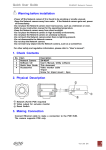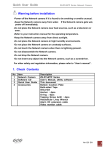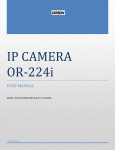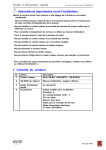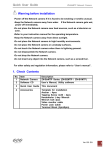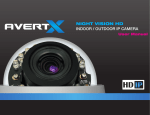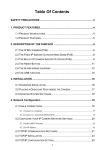Download User`s Manual - CBC (Europe)
Transcript
PixelPro Series ZN-M2AF User’s Manual 0 10-2014-A PixelPro Series ZN-M2AF User’s Manual SAFETY INSTRUCTIONS 1) Read these instructions. 2) Keep these instructions. 3) Heed all warnings. 4) Follow all instructions. 5) Do not use this apparatus near water. 6) Clean only with a dry cloth. 7) Do not block any of the ventilation openings. Install in accordance with the manufacturer's instructions. 8) Do not install near any heat sources such as radiators, heat registers, stoves, or other apparatus that produce heat. 9) Only use the attachments/accessories specified by the manufacturer. 10) Use only with a cart, stand, tripod or bracket specified by the manufacturer, or sold with the apparatus. When a cart is used, use caution when moving the cart/apparatus combination to avoid injury from tip-over. 12) Unplug this apparatus during lightning storms or when unused for long periods of time. 13) Refer all servicing to qualified service personnel. Servicing is required when the apparatus has been damaged in any way, such as power supply cord or plug is damaged, liquid has been spilled or objec ts have fallen into the apparatus, the apparatus has been exposed to rain or moisture, does not oper ate normally, or has been dropped. WARNING: ・To reduce the risk of fire or electric shock, do not expose this apparatus to rain or moisture. ・The apparatus shall not be exposed to dripping or splashing and that no objects filled with liquids, such as vases, shall be placed on the apparatus. 1 10-2014-A PixelPro Series ZN-M2AF User’s Manual Caution: Danger of explosion if battery is incorrectly replaced. Replace only with the same or equivalent type. These servicing instructions are for use by qualified service personnel only. To reduce the risk of electric shock does not perform any servicing other than that contained in the operating instructions unless you are qualified to do so. In USA and Canada, Use Class 2 Power Supply Only 2 10-2014-A PixelPro Series ZN-M2AF User’s Manual Contents 1. PRODUCT FEATURES ............................................................................................................................ 5 2. INSTALLATION ......................................................................................................................................... 6 2.1 INSTALL CAMERA.......................................................................................................................................... 6 3. ACCESSING THE CAMERA ................................................................................................................... 7 3.1 ACCESS FROM A BROWSER .......................................................................................................................... 7 3.2 ACCESSING THE CAMERA FROM THE INTERNET ........................................................................................... 8 3.3 ADJUSTING THE IMAGE ANGLE ..................................................................................................................... 8 3.4 THE LIVE VIEW PAGE.................................................................................................................................... 9 3.5 VIDEO STREAM TYPES ................................................................................................................................ 10 3.6 HOW TO STREAM H.264............................................................................................................................. 10 4. THE SETUP ............................................................................................................................................. 11 5. ANALOG OUTPUT ................................................................................................................................ 12 5.1 ANALOG OUTPUT SETUP ........................................................................................................................... 12 6. VIDEO ...................................................................................................................................................... 12 6.1 CODEC........................................................................................................................................................ 12 6.2 CAMERA ..................................................................................................................................................... 15 6.2.1 Exposure Control ............................................................................................................................. 15 6.2.2 Day & Night Control ......................................................................................................................... 16 6.2.3 White Balance Control..................................................................................................................... 17 6.2.4 Image Property Control ................................................................................................................... 17 7. LIVE .......................................................................................................................................................... 18 7.1 SETUP ...................................................................................................................................................... 18 7.2 PRIVACY MASKING .................................................................................................................................. 19 8. FTP ........................................................................................................................................................... 20 8.1 FTP > CONFIG ........................................................................................................................................... 20 8.2 FTP > EVENT ............................................................................................................................................. 20 8.3 FTP > PERIODICAL .................................................................................................................................... 21 9. EVENT ..................................................................................................................................................... 22 9.1 EVENT > MOTION ....................................................................................................................................... 22 9.2 EVENT > TAMPER DETECTION ................................................................................................................... 23 9.3 EVENT > MAPPING ..................................................................................................................................... 23 10. NETWORK ............................................................................................................................................ 24 10.1 NETWORK > IP SETUP ............................................................................................................................. 24 10.2 NETWORK > SERVICE PORT .................................................................................................................... 26 10.3 NETWORK > RTP..................................................................................................................................... 26 10.4 NETWORK > E-MAIL ................................................................................................................................. 27 10.5 NETWORK > DDNS ................................................................................................................................. 28 10.6 NETWORK > UPNP .................................................................................................................................. 29 11. SYSTEM................................................................................................................................................. 30 11.1 SYSTEM > USER....................................................................................................................................... 30 11.2 SYSTEM > DATE & TIME ........................................................................................................................... 31 11.3 SYSTEM > MAINTENANCE ........................................................................................................................ 32 11.4 SYSTEM > INFORMATION .......................................................................................................................... 34 3 10-2014-A PixelPro Series ZN-M2AF User’s Manual 12. DIMENSIONS ....................................................................................................................................... 35 13. SPECIFICATIONS ................................................................................................................................ 36 4 10-2014-A PixelPro Series ZN-M2AF User’s Manual 1. Product Features The GANZ PixelPro Series (ZN-M2AF) is a high performance H.264 network camera, designed for demanding security installations. It delivers crisp, clear images, disclosing every detail, thanks to its top quality Megapixel progressive CMOS sensor and advanced image processing. Supported by the industry’s largest base of video management software, the GANZ PixelPro provides the perfect solution for securing bank offices, airports and other facilities, and for traffic surveillance, over IP based networks. The optimal Power over Ethernet (IEEE 802.3af) support power to the camera to be delivered via the network, eliminating the need for a power outlet and reducing installation costs. Steady power could be guaranteed with a central Uninterruptible Power Supply (UPS). The GANZ PixelPro offers a comprehensive set of network security and management features. This includes support for port based network control (IEEE802.1X), which allows the camera to be connected to a network secured with this control, and HTTPS encryption, which provides a secure channel between camera and application. It also enables authentication of the video source. Video products are efficiently managed with the powerful GANZ PixelPro Camera Management tool, which is provided on the Installation CD which comes with each GANZ PixelPro camera. 5 10-2014-A PixelPro Series ZN-M2AF User’s Manual 1. Network (RJ-45 PoE required) The ZN-M2AF connects to the network via a standard network cable, and automatically detects the speed of the local network segment (10BaseT/100BaseTX Ethernet). This socket must be used to power the ZN-M2AF via Power over Ethernet (PoE). The camera auto-senses the correct power level when using a PoE switch, router or injector. 2. Video output for service monitor This analog video output is available when installation mode is set to ON. Use accessory cable to video output. 3. Reset Switch This switch has 3 functions by pressing time. 1) Switch NTSC / PAL format (less than 1second) 2) System reboot (around 5 seconds) 3) Factory Default Reset (More than 10 seconds) 2. Installation 2.1 Install camera 1) Assemble the tripod for fixing with wall bracket on Camera with supplied screws. 2) Fix the wall bracket on place that user want to install. 3) Connect the Wall bracket and Camera 6 10-2014-A PixelPro Series ZN-M2AF User’s Manual 3. Accessing the Camera Follow the instructions in the GANZ PixelPro Installation Guide to install the camera. The GANZ PixelPro could be accessed with most standard operating systems and browsers. The recommended browser is Internet Explorer for Windows with other operating systems. 3.1 Access from a browser 1. Start a browser (Internet Explorer) 2. Enter the IP address or host name of the camera in the Location/Address field of your browser. Press Enter. 3. Login dialog will appear when the camera is accessed for the first time. 4. The default user name is ADMIN, and password is 1234. 5. The camera’s Live View page is now displayed in your browser. Note: The layout of the live view page in the camera may have been customized to meet specific requirements. Consequently, some of the examples and functions featured here may differ from those displayed on your own Live View page. 7 10-2014-A PixelPro Series ZN-M2AF User’s Manual 3.2 Accessing the camera from the Internet Once installed, the camera is accessible on the local network (LAN). Configure the router/firewall to allow incoming data traffic to access the camera from the Internet. For security reasons this is usually done on a specific port. Please refer to the documentation for router/firewall for further instructions. 3.3 Adjusting the Image angle To adjust the image angle. 1. Open the Live View page in your web browser. - Select the Setup tab, and open the Analog output page. - Select the ‘Video Format' or “ON”. 2. Connect supplied video monitor cable to video output connector, then connect it to analog monitor with coaxial cable. - Adjust lens position. Or otherwise check the image from the Live View page on your web browser. - Adjust lens position. With Web Browser 1. Open the Live View page in your web browser. -Click ‘Lens Adjustment’ on the Live View or Select the Setup tab, and open the Video -> Camera page. 2. Set the desired Zoom position. 3. Click ‘One Push Focus’ button for adjust focus automatically or set focus manually. 8 10-2014-A PixelPro Series ZN-M2AF User’s Manual 3.4 The Live View page Digital Zoom Snap Shot Full Screen Video Stream change: First stream Second stream Play: Click this button by manually to start the stream Stop: Click this button by manually to stop streaming NOTE: It is possible that not all the buttons described below will be visible unless the Live View page has been customized to display them. 9 10-2014-A PixelPro Series ZN-M2AF User’s Manual 3.5 Video stream types H.264 protocols and communication methods • RTP (Real-time Transport Protocol) is a protocol that allows programs to manage the real-time transmission of multimedia data, via unicast or multicast. • RTSP (Real Time Streaming Protocol) serves as a control protocol, to negotiate the type of transport protocol to use for the stream. RTSP is used by a viewing client to start a unicast session. • UDP (User Datagram Protocol) is a communications protocol that offers limited service for exchanging data in a network which uses the Internet Protocol (IP). UDP is an alternative to the Transmission Control Protocol (TCP). The advantage of UDP is that, it is not required to deliver all data and may drop network packets when there is network congestion. This is suitable for live video, as there is no point in retransmitting old information that will not be displayed anyway. • Unicasting is communication between a single sender and a single receiver over a network. This means that the video stream goes independently to each user, and each user gets own stream. A benefit of unicasting is, in case one stream fails, it only affects one user. • Multicasting (Will be supported) is bandwidth-conserving technology that reduces bandwidth usage by simultaneously delivering a single stream of information to multiple network recipients. This technology is used primarily on delimited networks (intranets), as each user needs an uninterrupted data flow and should not rely on network routers. 3.6 How to stream H.264 Deciding on the combination of protocols and methods to use depends on your viewing requirements, and on the properties of your network. Setting the preferred method(s) is done in webpage. RTP+RTSP This method (actually RTP over UDP and RTSP over TCP) should be your first consideration for live video, especially when it is important to always have an up-to-date video stream, even if some images are lost due to network problems. This could be configured as multicast or unicast. RTP/RTSP/Multicasting (Will be supported) provides the most efficient usage of bandwidth, especially when there are large numbers of clients viewing simultaneously. Note however, that a multicast broadcast could not pass a network router unless the router is configured to allow this. For example, it is impossible to multicast over the Internet. 10 10-2014-A PixelPro Series ZN-M2AF User’s Manual RTP/RTSP/Unicasting should be used for video-on-demand broadcasting, so that there is no video traffic on the network until a client connects and requests the stream. However, as more and more unicast clients get connected, the traffic on the network will increase and may cause congestion. Although there is a maximum of 10 unicast viewers, note that all multicast users combined count as 1 unicast viewer. RTP/RTSP This unicast method is RTP tunneled over RTSP. This could be used to exploit the fact that it is relatively simple to configure firewalls to allow RTSP traffic. 4. The Setup The GANZ PixelPro is configured from the Setup link, which is available on the top left hand side in the web interface. This configuration could be done by: • Administrators, who have unrestricted access to all settings under the Setup tab. Accessing the Setup link from a browser 1. Start your web browser and enter the IP address or host name of the camera into the address bar. 2. The Live View page is now displayed. Click on the Setup tap. 11 10-2014-A PixelPro Series ZN-M2AF User’s Manual 5. Analog output Toggle menu changed to “ON/OFF” from FW1558 and later. 5.1 Analog Output Setup Toggle the Analog video output to “ON/OFF” from BNC output of the camera. Analog output allows selection of Video output format from BNC output of the camera. NTSC, PAL: Analog Output is selectable. This Analog Video Format menu moved to “Codec” page from FW1558 and later. 6. Video The following descriptions show examples of some of the features available in the GANZ PixelPro. 6.1 Codec These are the tools for adjusting the H.264 settings and controlling the video bit rate. 12 10-2014-A PixelPro Series ZN-M2AF User’s Manual H.264 This is a video compression standard that makes good use of bandwidth and which could provide high-quality video streams at less than 1 Mbit/s. The H.264 standard provides scope for a large range of different coding tools for use by various applications in different situations, and the GANZ PixelPro provides certain subsets of these tools. Using H.264, it is also possible to control the bit rate, which in turn allows the amount of bandwidth usage to be controlled. CBR (Constant Bit Rate) is used to achieve a specific bit rate by varying the quality of the H.264 stream. While using VBR (Variable Bit Rate), the quality of the video stream is kept as constant as possible, at the cost of a varying bit rate. Motion JPEG This format uses standard JPEG still images in the video stream. These images then are displayed and updated at a rate sufficient to create a stream that shows constantly updated motion. The Motion JPEG stream uses considerable amounts of bandwidth, but also provides excellent image quality and access to every individual image contained in the stream. Multiple clients accessing Motion JPEG streams could use different image settings. Codec H.264 / MJPEG Size Video output resolution. See the next page for the output resolution table. Frame rate 1~30fps in normal mode (1~15fps for slow shutter mode) Note: If the slow shutter mode is turned on and the low light condition is met, the frame rate is automatically goes down. In this case, the frame is half of the normal mode. GOP Size 1 ~ 60 frames Bit-rate control (CBR or VBR) When using H.264 compression, if there is only limited bandwidth available, a constant bit rate(CBR) is recommended, although this may compromise image quality. Use a variable bit rate(VBR) for the best possibly image quality. Average Bit-rate (512Kbps ~ 10Mbps) Recommended bit rate for D1: 800Kbps ~ 1Mbps Recommended bit rate for 1.3M(720p): 3Mbps ~ 4Mbps Recommended bit rate for 2.0M(1080p): 6Mbps ~ 8Mbps 13 10-2014-A ZN-M2AF User’s Manual PixelPro Series Analog Video Format Analog output allows selection of Video output format from BNC output of the camera. NTSC, PAL: Analog Output is selectable. Anti-Flicker mode (Flicker less mode) moved to “Camera” setup menu from FW1558 and later. 60Hz:NTSC 50Hz:PAL or flicker-free mode(to use the camera in locations lit by fluorescent lighting). Video Mirroring Video Mirroring mode can be set to None, Horizontal, Vertical or Flip (H+V). Bandwidth Limit Limit the bandwidth that the GANZ PixelPro can use during a network connection. Max Bandwidth Specify the maximum bandwidth that the GANZ PixelPro can use during a network connection. < Output resolution table for PixelPro> First Stream Second Stream 1920x1080 704x480 640x480 640x360 640x352 352x288 352x240 320x240 - 1280x1024 704x480 640x480 640x360 352x288 352x240 320x240 - - 1024x768 704x480 640x480 640x360 352x288 352x240 320x240 - - 1280x720 1280x720 704x576 704x480 640x480 640x360 352x288 352x240 320x240 704x576 704x576 640x480 640x360 352x288 - - - - 704x480 704x480 640x480 640x360 352x240 - - - - 640x480 640x480 320x240 - - - - - - 640x360 640x360 320x240 - - - - - - 352x288 352x288 - - - - - - - 352x240 352x240 - - - - - - - 320x240 320x240 - - - - - - - 14 10-2014-A PixelPro Series ZN-M2AF User’s Manual 6.2 Camera This section allows you to adjust various camera settings. 6.2.1 Exposure Control Exposure Mode Auto: Use this settings for automatic exposure control. Manual: Use these settings to control camera exposure manually. Auto (Motion Priority): Use this settings to be improved blurred images of the moving objects under low light conditions. Image noises would be increased under the low light conditions. *This function is available from FW1558 and later. To compensate for poor lighting conditions, you can adjust the Color level, Brightness, Sharpness, Contrast and Exposure control. NOTE: When AE is enabled, some of the submenus (AGC Gain, e-Shutter Speed) will be disabled. Max AGC Gain For low light conditions, adjust to a higher value, such as 36dB. Max AGC Gain can be set to LOW, MID or HIGH. 15 10-2014-A PixelPro Series ZN-M2AF User’s Manual Max Shutter Speed Slowest shutter speed can be selected from the menu. *This function is available from FW1558 and later. Anti-Flicker Mode (Flicker less mode) Anti-Flicker Mode can be set to 60Hz, 50Hz or OFF. 60Hz: NTSC 50Hz: PAL or flicker-free mode (to use the camera in locations lit by fluorescent lighting). OFF (This mode is available from FW1558 and later.) Slow Shutter For low light conditions, turn on slow shutter mode. Slow shutter speed can be set to x2, x4, x8 or OFF. BLC Control (Back Light Compensation) The BLC adjusts the exposure of scenes with strong backlight in the center-bottom of the image. When the image background is too bright, or the objects are too dark, backlight compensations make the objects appear clearer. The settings for low light behavior determine how the camera behaves at low light levels. These settings affect video image quality and noises appears on the images. The BLC can be set to Adaptive, Zone or OFF. “Adaptive” and “Zone” functions are available from FW1558 and later. Adaptive: The mode works detections and compensations automatically. Zone: Can be set the detections areas for BLC behaviors from Lower, Middle, Upper, Left or Right. 6.2.2 Day & Night Control Day & Night Mode Auto/Day/Night/Schedule- If set to Auto, the camera will automatically switch according to the current lighting conditions. Schedule- You can specify the schedule of Day mode. * Schedule is available from FW1333 and later. 16 10-2014-A PixelPro Series ZN-M2AF User’s Manual 6.2.3 White Balance Control WB (White Balance) Mode WB mode can be set to Auto, Auto (wide mode), Custom (one-shot mode), WB Hold or Manual. “Custom” / “WB Hold” functions are available from FW1558 and later. Auto: ATW (Auto Tracking White balance) The White balance adjustment setting is used to make the colors in the image appear consistent, compensating for the different colors present in different light sources. The GANZ PixelPro camera can be set to automatically identify the light source and compensate for its color temperature. Auto (wide mode): WB adjustment range is wider than Auto mode. Custom (one-shot mode): WB will be fixed after adjusted WB in ATW, and then the mode to be switched to the WB Hold mode automatically. WB Hold: When the WB Hold was enabled, WB to be fixed. Manual: When Manual White Balance is enabled, WB mode for the light sources can be selected from the following fixed mode; Indoor (2800K), Outdoor (6500K), or Fluorescent (4000K) 6.2.4 Image Property Control Modify the video signal parameters, such as: Brightness, Sharpness, Contrast, and Color. Sharpness (Default: 8, Range: 1~15) Brightness (Default: 15, Range: 0~30) Contrast (Default: 15, Range: 0~30) Color (Default: 15, Range: 0~30) 17 10-2014-A PixelPro Series ZN-M2AF User’s Manual 7. Live 7.1 Setup The GANZ PixelPro could support 10 simultaneous users. In case of multicast, the GANZ PixelPro could support unlimited number of users. If supported on the network, consider using multicasting, as the bandwidth consumption will be much lower. Viewer Setup LiveView Protocol RTP Unicast (UDP) / RTP Multicast (UDP) / RTP over RTSP (TCP) Buffering Time (frame based) Determines (0 ~ 90) x 1/30 sec (0 ~ 3sec) Viewer OSD Setup Date : Determines whether the date is displayed. Resolution : Determines whether the camera title is displayed. Event State : Determines whether the event state is shown on display window. 18 10-2014-A PixelPro Series 7.2 ZN-M2AF User’s Manual Privacy Masking This uses masking to hide sections that you do not want to appear in the shooting screen. Maximum 2 locations can be hidden with color. Mask Area All View:Shows the masking area both Area 1 and 2. Click the Masking Area 1 or 2 to make a masking. Mask color Sets the mask color Black, White, Light Gray, Dark Gray, Yellow, Red, Blue, Green Mask Creation Procedure 1. Click Privacy Mask in the Live menu. 2. Select Area1 or 2 to activate a setup window. 3. Set the Mask Color in the drop-down list. 4. Click the Masking window, and select an area that you want to specify the masking area. 5. Click Save. Note: When the Privacy Masking is set, analogue output will be changed to OFF state automatically. * Privacy masking is available from FW1227 and later. 19 10-2014-A PixelPro Series ZN-M2AF User’s Manual 8. FTP 8.1 FTP > Config Server Configuration (This function is N/A on this model) External Server Configuration It is setting page to transmit the still shot to remote sites, using the FTP server. Specify the external FTP server information such as IP address, port number, Username and password. Note : When the first stream is set to 1920x1080, please set the 2nd stream to MJPEG or H.264 with resolution less than 352x288. If 2nd stream is set to H.264 greater than 640x352, 30fps streaming is not guaranteed due to performance limitation. 8.2 FTP > Event 20 10-2014-A PixelPro Series ZN-M2AF User’s Manual Event FTP Sending It enables FTP transmission triggered by event. Directory : This folder will be created into external FTP server automatically. File Prefix : The file name will start from this prefix. Mapping : You can specify event mapping for Event FTP. Effective Period : You can specify “Always” or “Schedule” 8.3 FTP > Periodical Periodical FTP Sending It enables FTP transmission periodically. Directory : This folder will be created into external FTP server automatically. File Prefix : The file name will start from this prefix. Interval : You can specify interval time for uploading to FTP. Effective Period : You can specify “Always” or “Schedule” 21 10-2014-A PixelPro Series ZN-M2AF User’s Manual 9. Event 9.1 Event > Motion Motion Detection Motion detection is used to generate an alarm event with analyzes the video whenever objects movements occurs in the video image. Maximum 4 windows can be configured. Area Sensitivity:1(low) ~ 10(High) – The higher the number is, the higher the sensitivity level becomes. Configuring Motion Detection 1. Click Motion Detection in the Event Config menu. 2. Select an Area from Area1 to 4 to activate a Motion setup window. 3. Click the Motion window, and select an area that you want to specify the Motion area. 4. Select sensitivity value (1 ~ 10) in the drop-down list. Any detected motion within an active window is then indicated by red shade onto the Activity window. 5. Click Save. Note: Using the motion detection feature might decrease the camera’s overall performances, depending on camera settings. 22 10-2014-A ZN-M2AF User’s Manual PixelPro Series 9.2 Event > Tamper Detection Tamper Detection Camera detects the tampering with analyzes the video image. When the camera angle is moved, covered or sprayed to the Lens, defocusing severely, it can be triggered to an alarm event. Tamper detection can be set to LOW, MID, HIGH or OFF. Notes: Too simple or dark background cause detection fail ratio. Indoor light (or similar situation) turn ON or OFF would cause False Detections. If the video scene is similar or same between ‘before’ and ‘after’ angle change, it cause detection fail. This function is added from FW1558 and later. 9.3 Event > Mapping It is possible to define conditions that would cause the camera to respond with certain actions. A triggered event happens as a result of a trigger, which could be motion detection or tamper detection. For example, E-mail could be sent by video motion detection or tamper detection. 23 10-2014-A PixelPro Series ZN-M2AF User’s Manual 10. Network 10.1 Network > IP Setup Network Settings Click the Setup > Network > IP Setup to see the current network settings. IP Address Configuration The GANZ PixelPro supports both IP version 4 and IP version 6 (IPv6 will be supported in V3.00). Both versions may be enabled simultaneously, and at least one version should be always enabled. When using IPv4, the IP address could be set automatically via DHCP, or a static IP address could be set manually. If IPv6 is enabled, your camera receives an IP address according to the configuration in the network router. There are also options for setting up notification of changes in the IP address, and for using the Internet Dynamic DNS Service. Notes: • To receive notification whenever the camera’s IP address changes (via e.g. DHCP), configure the options for notification of IP address change. See Services below. • If your DHCP server could update a DNS server, you could access the GANZ PixelPro by a host name which is always the same, regardless of the IP address. DNS Configuration DNS (Domain Name Service) provides the translation of host names to IP addresses on your network. •1st DNS server Enter the IP address of the primary DNS server for your network. •2nd DNS server Enter the IP of the Secondary DNS, which is used if the Primary DNS server is unavailable. 24 10-2014-A PixelPro Series ZN-M2AF User’s Manual How to assign IP address Default setting is set to “DHCP” and “UPnP” function is set to ON. If your network has DHCP server and UPnP function is enabled on your PC, you can find the network camera in “My network”. If DHCP server is not available in your network, please assign IP address as following process. ② ③ ④ 1) 2) 3) 4) Execute “MultiUpgradeTool.exe”, it will search the camera on the network. After the camera is listed in camera list, select the camera. Type in the all network information. Click “Change IP address” button to set network settings to the camera. When you double-click the camera within the list, the default web browser (Internet Explorer or compatible equivalent) will open and automatically connect to the camera. 25 10-2014-A PixelPro Series ZN-M2AF User’s Manual 10.2 Network > Service Port Service Port HTTP port- The default HTTP port number (80) could be changed to any port within the range 1-65535. This is useful for simple port mapping. RTSP port- The RTSP protocol allows a connecting client to start an H.264 stream. Enter the RTSP port number to use. The default setting is 554. NOTE: After changing the default port numbers, the user can use the “MultiUpgradeTool.exe” to search and connect automatically. 10.3 Network > RTP RTP port range, Multicast Setup These settings are the IP address, port number, and Time-To-Live value to use for the video stream(s) in multicast H.264 format. Only certain IP addresses and port numbers should be used for multicast streams. 26 10-2014-A PixelPro Series ZN-M2AF User’s Manual 10.4 Network > E-mail You must turn Notification to ‘On’ and then enter the host names or addresses for your mail servers in the fields provided, to enable the sending of event and error email messages from the camera to predefined addresses via SMTP. Note1) Frequency : Mail server may register the sender to SPAM list when frequency is set to “1 Min”. It may be better to set “5 Min” for safe side. Note2) From : Specify the name who sent e-mail notification. It may be better to use e-mail format like as [email protected]. Some e-mail server will refuses it. 27 10-2014-A PixelPro Series ZN-M2AF User’s Manual 10.5 Network > DDNS How to setup the DDNS: 1) DDNS set to ON. “Mac address.dvrlink.net” is registered to the DDNS server. User can connect to the camera with: “http://mac address.dvrlink.net”. 2) DDNS set to ON and user inputs “user-defined name”. “Mac address.dvrlink.net” and “user-defined name.dvrlink.net” are both registered together. User can connect to the camera using either: “http://mac address.dvrlink.net” or “http://user-defined name.dvrlink.net”. If “user-defined name” is already registered, an error message is shown, try a different name. 28 10-2014-A PixelPro Series ZN-M2AF User’s Manual 10.6 Network > UPnP Universal Plug & Play (UPnP) allows you to find the IP camera automatically on your network. In order to be able to detect the camera automatically, you must enable the UPnP function on both the camera and on your PC. Camera : Set UPnP to “ON” PC : Open “Control Panel” >”Network Connection” Select “Advanced” >”Optional Networking Components…” 29 10-2014-A PixelPro Series ZN-M2AF User’s Manual Select “Network Services” and click “Details”. Then select “UPnP user Interface” 11. System 11.1 System > User Access the camera and the Configure Root Password dialog appears. Enter the User name: ADMIN and password is 1234. To changed password or add a user click SETUP > SYSTEM > USER. Fill the User ID, Password and E-mail server. Select Group. Then press ADD button and click SAVE. Note: The default administrator user name ADMIN is permanent and could not be deleted or altered. 30 10-2014-A PixelPro Series ZN-M2AF User’s Manual 11.2 System > Date & Time Date & Time Format - specify the formats for the date and time (12h or 24h) displayed in the Live View video streams. Use the predefined formats or use your own custom date and time formats. Network Time Server - the camera will obtain the time from an NTP server every 60 minutes. Specify the NTP server's IP address or host name. Time zone setup – Select your time zone from the drop-down list. D.S.T (Daylight Saving Time) - ON/OFF 31 10-2014-A PixelPro Series ZN-M2AF User’s Manual 11.3 System > Maintenance System Name Choose a system name to identify the camera when using e-mail notifications. System Reboot Reboot the camera. Factory Default To reset the camera settings to the original factory default settings. Enable Firmware Upgrade / Firmware Updates To upgrade Firmware of the camera, follow the instruction below. NOTE: Preconfigured and customized settings should be saved before the firmware is upgraded. 1) Enable Firmware Upgrade mode with clicking “OK” of Enable Firmware Upgrade menu. 2) The camera automatically switches to Firmware Upgrade mode. 32 10-2014-A PixelPro Series ZN-M2AF User’s Manual 3) When Firmware upgrade menu is displayed, browse to the desired firmware file on your computer. Click OK. NOTE: Do not disconnect power to the unit during the upgrade. The unit will restart automatically after the upgrade has completed. (1~5 minutes) System Reset (Factory Default Reset) There are two ways to reset the camera back to factory default. holding down about 1020 sec the reset button on the Camera Using the web browser: 1. Go to SETUP > System > Maintenance. 2. Click Factory Default Button and wait 1 minute for camera to reboot. Using the Reset Button: 1. Holding down 10-20 sec the reset button on the Camera. 2. Release your finger on the reset button, waiting about 1 minute for camera reboot NOTE: The unit will now have the default IP address from a DHCP server. Use the ‘“MultiUpgradeTool.exe” to discover and connect to the camera. 33 10-2014-A PixelPro Series ZN-M2AF User’s Manual 11.4 System > Information System Information You can confirm the system information about the camera here. 34 10-2014-A PixelPro Series ZN-M2AF User’s Manual 12. Dimensions 35 10-2014-A ZN-M2AF User’s Manual PixelPro Series 13. Specifications H.264 / MJPEG Network Camera Dual Stream Motion Triggered Alarm Multi Language GUI support ONVIF Compliant 1/2.8" Sony IMX036 CMOS Sensor On The Fly supported @ GOP/Bitrate/FPS stetting 2D DNR. (Depends on CODEC configuration) DPC(Defective Pixel Correction) on the fly Analog Hybrid Output(Installation Only) Privacy Masking Auto Focus for Easy Installation True Day & Night Product Features Image Sensor Max. Resolution 1920 x 1080 Effective Pixels 2096(H) x 1561(V) Effective Image Size White Balance Electronic Zoom AGC BLC Iris CAMERA Shutter Speed Slow Shutter Lens Angle of View Day & Night S/N ratio Min. illumination ANALOG (Installation Only) AUDIO 1/2.8" Sony IMX036 CMOS Sensor Privacy Masking Video Signal Monitor Output Scanning Frequency In/Out CODEC 5.24mm(H) x 3.90mm(V), 6.53mm(Diagonal) ATW / MANUAL(PRESET) 2 ~ 10x (Client Software) Yes Yes 1/4, 1/10, 1/12.5, 1/15, 1/20, 1/25, 1/30, 1/50, 1/60, 1/100, 1/120, 1/240, 1/480, 1/960, 1/1024, 1/2000s 2x, 4x, 8x Optical 5X Megapixel Zoom Lens, f=5.0~25.0 mm f=5mm(wide)> horizontal definition:51.3° f=25mm(tele)> horizontal definition:11.0 Removable IR Cut Filter 48.8 dB or more 3.8 lux (F3.5, 50IRE) :Color, AGC High 0.08 lux (F3.5 50IRE) ;B/W, AGC High Up to 2 Areas NTSC / PAL selectable Composite Output(BNC), 75 ohm 1Vpp NTSC: (H) 15.734 kHz, (V) 59.94 Hz PAL: (H) 15.625 kHz, (V) 50 Hz - 36 10-2014-A ZN-M2AF User’s Manual PixelPro Series Network Image Compression 10BASE-T, 100BASE-TX, RJ45 H.264 MJPEG : Image quality: 100 Steps(Q value) 1920 x 1080(Full HD), 1280 x 1024(SXGA), Resolution 1024x768(XGA), 1280 x 720(720p) 640 x 480(VGA), 640 x 360(HVGAW), 320 x 240(QVGA) 704x480/576(4CIF), 352x240/288(CIF) IPv4, HTTP, SMTP, UPnP, DNS, Protocol RTSP, DDNS, RTP, TCP, UDP, RTCP DHCP, ARP, ICMP, IGMP, NTP Frame Rate NETWORK 1 fps ~ 25 fps / 1 fps ~ 30 fps Internet Explorer 7.0 or above Web Browser Firefox Chrome Smart Phone (iOS, Android) Security Password Protection SDK(API) HTTP / RTSP based API ONVIF VMD Alarm Trigger Alarm Event Power Source POWER Power Consumption Micro SD Card External I/O Terminals IR Number OTHER SPECIFICATIONS Ambient Temperature (Not Include Cold Start) Ambient Humidity Materials User set 4 ROI (Region Of Interest) 10 Step Sensitivity VMD E-mail notification(Snapshot), FTP transfer(Snapshot), MJPEG image streaming with alarm status(TBD) PoE (IEEE 802.3af compliant) 114mA @ DC48V, Max 5.5W 0ºC ~ 50ºC(32ºF~122ºF) less than 90%, Non-condensing Aluminum Diecasting 160g Weight 50.6(W) X 47.4(D) X 62.8(L) mm Dimensions(W x H x D) * The specifications and/or appearance of the product may change without a prior notice. 37 10-2014-A PixelPro Series ZN-M2AF User’s Manual 38 10-2014-A PixelPro Series ZN-M2AF User’s Manual 39 10-2014-A PixelPro Series ZN-M2AF User’s Manual 40 10-2014-A PixelPro Series ZN-M2AF User’s Manual 41 10-2014-A ZN-M2AF User’s Manual PixelPro Series Revision History REV# 06-2014-A 10-2014-A DATE(M/D/Y) 06/17/2014 10/30/2014 Comments Revised all the pages Added Specifications Modified to True Day & Night Additions and revisions for new FW(1558). Minor update on some pages. 42 10-2014-A













































